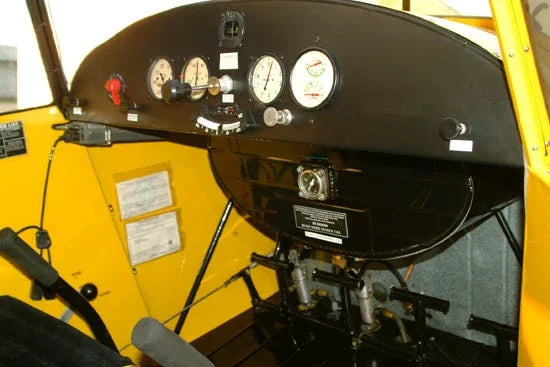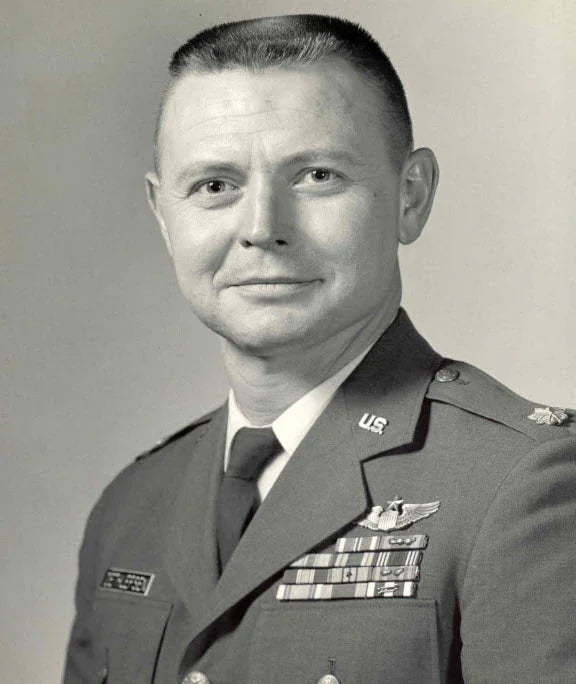Charles F. Blair Jr., Aviation Pioneer

Charles F. Blair Jr. was born on July 19, 1909, in Buffalo, New York, and he was destined to become an aviation pioneer.
At the age of 19 he made his first solo in San Diego, CA, and continued his fledgling aviation career while earning a Bachelor of Science degree in mechanical engeering at the University of Vermont in 1931.
The following year he was commissioned as an Ensign as a naval aviator in the Naval Reserve. He served a tour in the Navy as a fighter pilot, remaining in the navy reserves while taking flying jobs.
For the next seven years he flew for Boeing Air Transport which held the contract for the Chicago-San Francisco portion of the transcontinental mail route.
In 1940 Blair became the chief pilot for American Export Airlines where he trained pilots.
American Export Airlines became American Overseas Airline which flew three trips a week between New York City and Southampton, England.
The airline used 14 flying boats in it's fleet (1 PBY-4, 3 Sikorsky VS-44s, 1 DC-3, 2 Douglas C-47s and 7 Douglas C-54s) until 1946.

An American Export Airline Sikorsky VS-44 flying boat in flight.
Specifications of the Sikrosky VS-44 Flying Boat
- Wingspan: 124 feet;
- Height over nacelles: 16 feet 7 inches;
- Height over tail: 27 feet, 7.25 inches;
- Length: 79 feet 3 inches;
- Beam of hull: 10 feet;;
- Crew: 4-5;
- Empty weight: 26,407 lbs;
- Gross wight: 57,500 lbs;
- Maximum speed: 210 mph;
- Cruise speed: 175 mph;
- Range: 3,598 miles;
- Service Ceiling: 18,996 feet.
The flights made stops in Newfoundland and Foynes, Ireland to refuel between New York and England.
World War II
Blair was recalled to active duty where he flew flying boats for the The Naval Air Transpot Service came into existence right after Pearl Harbor was attacked by Japan on 12-11-41. The idea for the Naval Air Transport Service was born on 12-11-1941, the same day that I was born!
On March 9, 1941, the Naval Air Transport Service began with the establishment of the first Transport Squadron, VR-1, the first of thirteen squadrons of its kind.
It was given the job of carrying personnel, equipment, and cargo using the venerable Douglas DC-3s, PB2Y Coronados, the Martin Mars, and two of the famed Pan American clippers.

PBY-2 Coronado in US Navy livery taking off from the water.
Specifications of the PBY-2 Coronado
| Manufacturer: | Consolidated Aircraft Corporation |
| Type: | Patrol bomber |
| Crew: | Ten |
| Powerplant: | Four 1,200 hp Pratt & Whitney R-1830-88 engines |
| Dimensions: |
Length: 79 ft., 3 in. |
| Performance: |
Max Speed: 213 mph at 20,000 ft. |
| Armament: |
Eight .50-caliber flexible mount guns; |
Bliar flew a number of these flying boats during the war, including one interesting trip in a Sikorsky VS-44 aircraft.
On a return trip from Foynes, Ireland he passed up his refuleing stop in Newfoundland, arriving in New York after 25 hours and 45 minutes!
Blair became the first pilot to fly a flying boat across the Atlantic Ocean non-stop.
Following the war, Blair was placed in charge of flight testing the Lockheed Constellation and the Boeing Stratocruiser airliners for American Overseas Airlines, and he oversaw their introduction on the new transatlantic routes.
The P-51 Mustang, Excalibur III
After the war Blair went to work for Pan American World Airways, and due to Blairs extensive long distance flying decided to purchase a P-51C-10-NT Mustang for Blair to use to attempt some new long distance flight records.
The aircraft they chose was a P-51C-10-NT Mustang which had been flown by Paul Mantz who won the transcontiental Bendx Trophy air races in 1946 and 1947.
The P-51C had been christened "Blaze of Sun" by Mantz.

Paul Mantz in the cockpit of “Blaze of Noon,” P-51C-10-NT Mustang 44-10947, NX1202 preparing for yet another race.
Once acquired by Pan Am the Mustang was rechristened "Excalibur II" to be used by Blair to set some distance speed records.

North American Aviation P-51C-10-NT 44-10947, “Excalibur III,” on exhibit at the Steven F. Udvar-Hazy Center in Chantilly, VA.
Paul Mantz had removed the standard 90-gallon tanks from each wing and converted the aircraft to a "wet wing" fuel tank.
Specifications:
- Wingspan: 37 feet, 0.31 inches;
- Length: 32 feet, 2.97 inches;
- Height: 13 feet, 8 inches;
- Empty weight: 6,985 lbs;
- Maximum gross weight: 11,800 lbs;
- Engine: Packard V-1650-3 Merlin V-12;
- Maximum horsepower at Sea Level: 1,490 hp;
- Maximum speed: 439 mph;
- Cruise speed: 362 mph;
- Service ceiling: 41,900 feet.
January 31, 1951:
On Januaary 31, 1951 Captain Blair took "Excalibur III", a P-51C-10-NT Mustang, NX1202, from the New York International Airport to the London Airport in 7 hours and 48 minutes, averaging 446 mph and flying at 37,000 feet where the jet stream was.
Blair told The Salt Lake Tribune on June 3, 1951 that "At last, I was riding the jet stream, pushed by a tailwind exceeding 200 miles per hour. . . Above me, the sky was empty and blue; below the wings of my tiny aircraft a winter storm raged. Its upper canopy of white clouds gave it a look of complete innocence.”
Blair's flight did not set an official record; however, it was his 401st Atlantic crossing as a pilot.

Charles F. Blair, jr. arrives at Heathrow Airport in London, England.
Interestingly, "Excalibur III was impounded by HM Customs at the London Airport. Blair had not paid the £800 customs duty which would have allowed the Mustang to stay for six months. He would have had to fly the airplane back to the United States to avoid the aircraft being impounded.
The Chicago Daily Tribune reported the event:
LONE PILOT HOPS OCEAN IN LESS THAN 8 HOURS
LONDON, Jan. 31 (AP)— Airline Capt. Charles Blair landed his scarlet red Mustang fighter plane in a blaze of red flares tonight, chalking up a New York to London speed record of 7 hours 48 minutes. He clipped an hour and seven minutes off the old record.
Blair said his only troubles during the flight were some icing in the early stages and a painfully tight pair of boots.
As he climbed from the cockpit of the flying gas tank named Excalibur III and waved to a cheering crowd at London airport he winced and declared: “The first thing I do is get these boots off.”
Aided by Tail Winds
Blair left New York’s Idlewild airport at 3:50 a.m. Chicago time [09:50 UTC] and was clocked in here at 5:38 p.m. British time [11:38 a.m. Chicago time]. [17:38 UTC]
A Pan American Airways pilot, Blair took the time record from a Pan American Stratocruiser which made the eastward Nov. 22, 1949, with 24 passengers, in 8 hours and 55 minutes. Strong tail winds helped in both cases.
Blair, tall, dark, married, and 41, brought no luggage, but had a shaving kit and a tooth brush in a small leather bag.
His plane is powered by a Packard built Rolls-Royce Merlin engine and was modified to hold 863 gallons of gasoline inside wings and fuselage without external tanks. He said the plane cost $25,000 to buy and revamp.
Averages 450 M. P. H.
Blair told newsmen at London airport: “It was a very good crossing. It wasn’t as fast as I expected, but after Gander, N.F., I had a tail wind of 130 miles an hour. But the weather wasn’t too good and there was some ice.”
Blair’s average speed was about 450 miles an hour and he made much of the jaunt at 37,000 feet.
He said the trip had a dual purpose, to break the record and to study the effect of high velocity winds on airliners in the lower stratosphere.
A British PATHÉ news film of Blair’s arrival at London can be seen on YouTube:
Blair will fly back to New York as a passenger in a Stratocruiser. He has to return by Saturday. On that day he will fly a planeload of passengers from New York to London.
But Blair was not done yet.
May 29, 1951:
On May 29, 1951, Blair flew the "Excalibur II" from Bardufoss, Norway to Fairbanks, Alaska via the North Pole.

Captain Charles F. Blair, Jr., standing in the cockpit of Pan American World Airways’ North American Aviation P-51C Mustang, Excalibur III, Bardufoss, Norway, 29 May 1951.
The flight took 10 hours and 27 minutes, covering a distance of 3,260 miles, crossing the North Pole at 22,000 feet. During this flight the Mustang was subjected to -25 degrees Fahrenheit.
To accomplish this feat Captain Blair used an Astro Compass Mark II on his transpolar flight using a system of pre-plotted sun lines calculated for him by Captain Phillip Van Horns Weems as the magnetic compass was useless over the course.

Charles Blair used this Astro Compass Mark II on his transpolar flight.
On November 18, 1952 Blair was presented the Harmon International Trophy for his "outstanding international achievements in the art and/or science of aeronautics for the previous year, with the art of fling receiving first consideration" by then President Truman.
Captain Blair's Demise
During his lifetime Blair married four times, the last time on March 11, 1968 to the actress Maureen O'hara. He met Ms. O'hara on a flight to Ireland in 1947.

A Grumman G-21 similar to the one Blair was flying the day of his accident.
On September 2, 1978, Captain Blair was piloting a Grumman Goose seaplane for his airline, Antilles Air Boats in the U.S. Virgin Islands - "A look at a time gone-by".
Blair was PIC (Pilot in Command) of Antilles Air Boats Flight 941, carrying 10 passengers. Near the end of the flight the left engine suffered a catastrophic failure.
Blair was five miles from St. Thomas island flying at 1,700 feet when a cylinder failed which then struck the engine cowling breaking off its mountings on the port nacelle.
Blair immediately feathered the propeller and shut down the engine.
The Grumman Goose should have been able to maintian altitude, however, the aircraft began a slow descent towards the water. Blair called the St. Thomas tower reporting the loss of an engine, and that he would need some assitance.
He decided to land in the protected waters of West Gregerie Channel, and requested a boat to pick up his passengers.
Unfortunately, the sea was rough with 15 to 20 knot winds which were generating whitecaps and swells of 5 to 6 feet.
Capt. Blair did not give emergency instructions to his passengers,he did not tell them to expect a water landing, never turned into the wind, nor did he lower any flaps.
The aircraft hit the ocean's surface at a high rate of speed, with the right wing low. It bounced off the first contact with the water, flew another 3 or 4 plane lengths, came back down, buried the port wing float causing the aircraft to cartwheel breaking apart before finishing upside down in the water.
No one was killed in the crash; however three passengers and Capt. Blair drowned.
The NTSB investigated the accident and found numerous violations regarding proper maintainence and false aircraft logbook entries, all with the full knowledge of management, supervisors, and licensed personnel.
His wife, actress Maureen O'Hara, took over management of the company becoming the first woman to become president of a United States based airline.
I hope you enjoyed this trip through some of the history of aviation. If you enjoyed this trip, and are new to this newsletter, sign up to receive your own weekly newsletter here: Subscribe here!
Until next time, keep your eyes safe and focused on what's ahead of you, Hersch!







Leave a comment
This site is protected by hCaptcha and the hCaptcha Privacy Policy and Terms of Service apply.